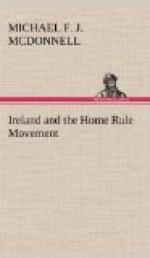Coelum non animum mutant qui trans mare currunt; the Ulster Protestants who were driven from their country by the commercial restrictions of the eighteenth century formed the nucleus of the most implacable enemies of Great Britain in the War of Independence—half Washington’s army was recruited from Irishmen in America; and in the same way the exiles of the nineteenth century became, and have remained even to the second generation, irreconcilable adversaries of the system of government which, by affording for too long no relief to the conditions in Ireland, was responsible for the flight from their home to a land which was, by comparison, flowing with milk and honey.
Side by side with emigration goes on another factor in the social life of the country which is very significant of the stress under which, in some districts, the Irish peasant ekes out an existence. I am referring to the migratory labourers, of whom nearly 18,000 leave their homes in Ireland every year to work in the harvest fields of England and Scotland, that they may there secure a wage by which they are able to make both ends meet in a manner which the uneconomic nature of their holdings does not permit. How small is the diminution in this annual migration is seen by the fact that the highest figures in connection with it recorded in the last quarter of a century are those of 1880, in which year nearly 23,000 migrated, while within the last six years—in 1901—the figures were as high as 19,700. More than three-quarters of these labourers come from Connacht, and of the total number more than one-half from County Mayo, from which every year 47.8 per thousand of the population migrate, and if one takes the adult male population—i.e., that of men over twenty years of age—one finds that the number of migratory labourers represents a proportion of 177.4 per thousand. Nearly three-quarters of them go to England, and the harvest fields of Lincolnshire and Yorkshire are in a large measure reaped by their hands. From February till June the migration occurs, and the labourers return in the late autumn to their homes. The fact that the sum brought back by them is, at the highest estimate, said to be about L18 after nine months of labour, and that the wages which they earn amount to an average of 17s. a week, while, in addition to the cost of living for three-quarters of the year, about L2 is spent on their railway fare, all serve to show the nature of the economic conditions in the West of Ireland which make such a migration for such a wage worth while on the part of nearly twenty thousand people. One factor in this connection which should be noted is that the number of girls who migrate every year is said to be increasing, and is estimated to amount to nearly half the total throughout the country. The precariousness of a dependence on such a means of subsistence as this, is seen from the fact that a bad harvest in England or a development in agricultural machinery would put an end to the source of livelihood which it provides. If from no other point of view the problem should be regarded seriously by Englishmen in the light of the depopulation of the English countryside, with its direct bearing upon the material for recruiting the army and navy, and the problem of unemployment in general.




